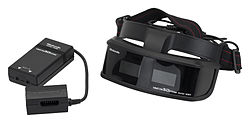
Back Famicom 3D System Spanish ファミコン3Dシステム Japanese Famicom 3D System Portuguese Famicom 3D System Russian
| Manufacturer | Nintendo |
|---|---|
| Type | Video game accessory |
| Generation | Third generation |
| Lifespan |
|
| Connectivity | Famicom expansion port 2 3.5 mm jacks (glasses) |
The Family Computer 3D System[1], commonly known as the Famicom 3D System[2], is a stereoscopic video game accessory produced by Nintendo for its Family Computer (Famicom) console.[3] It was released exclusively in Japan on October 21, 1987, at an MSRP of ¥6,000.[4][5] The 3D System consists of a pair of active shutter glasses (model HVC-031) and an adapter (model HVC-032) that connects up to two of them via 3.5 mm jacks;[6][7] the latter connects to the Famicom's expansion port and includes a passthrough port to allow connection of other accessories that use the expansion port.[4] Compatible games would play in conventional 2D until a "3D mode" was activated via a button press or combination, which allowed them to display a stereoscopic image in a similar manner to the SegaScope 3-D glasses for Sega's Master System.[8][9]
The 3D System was a commercial failure and, as a result, was never released outside Japan.[3] Criticisms included the clunkiness of the glasses and the limited selection of compatible titles.[10][11] Compatible games that received a release outside Japan were recoded for compatibility with anaglyph 3D glasses instead.[8] Eight years later, in 1995, Nintendo again ventured into stereoscopic gaming with the commercially unsuccessful Virtual Boy. In the following years, Nintendo experimented in stereoscopic 3D with both the GameCube and Game Boy Advance SP systems, but these features were not released commercially due to cost and technical limitations.[12] In 2011, Nintendo released the 3DS handheld capable of displaying stereoscopic 3D images without the need for special glasses. The 3DS has enjoyed a largely positive reception. In 2019 Nintendo released a Labo VR Kit.
- ^ Japanese: ファミリー コンピュータ スリーディー システム, Hepburn: Famirī Konpyūta Surī Dī Shisutemu
- ^ Japanese: ファミコン スリーディー システム, Hepburn: Famikon Surī Dī Shisutemu
- ^ a b Plunkett, Luke (30 April 2010). "Nintendo's First 3D Technology Shot A Spaceship At Mario's Face". Kotaku.
- ^ a b "ファミコン年表" [History of Family Computer]. ファミコン40周年 [Famicom 40th Anniversary]. Nintendo. July 15, 2023. Retrieved December 24, 2024.
- ^ Family Computer 3D System (Flyer) (in Japanese). Nintendo. 1987.
- ^ Family Computer 3D System: Instruction Manual (in Japanese). Nintendo. 1987.
- ^ Lane, Gavin (December 25, 2020). "Nintendo Console Codenames And Product Codes". Nintendo Life. Retrieved December 24, 2024.
- ^ a b Foster, Neil (November 19, 2017). "Rad Racer". Hardcore Gaming 101. Retrieved December 24, 2024.
- ^ Cite error: The named reference
FSK-ANM manual - Jalecowas invoked but never defined (see the help page). - ^ Bertoli, Ben (June 4, 2017). "That Time Nintendo and Sega Introduced 3D Gaming, In 1987". Kotaku. Retrieved December 24, 2024.
- ^ "Decades Ahead of Its Time: The Famicom 3D System". Nintendo Force. No. 33. May–June 2018. p. 54.
- ^ Cite error: The named reference
iwata askswas invoked but never defined (see the help page).
